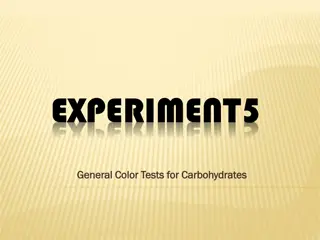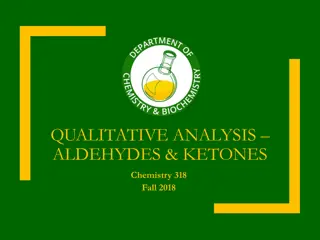Understanding Carbohydrates: Qualitative Tests and Classification
Carbohydrates serve as a crucial energy source and structural element in living organisms. This lab explores the qualitative tests and classification of carbohydrates, including monosaccharides, disaccharides, oligosaccharides, and polysaccharides. Learn about the properties and distinctions of different carbohydrate types and how they can be broken down into simpler units through processes like hydrolysis.
Download Presentation

Please find below an Image/Link to download the presentation.
The content on the website is provided AS IS for your information and personal use only. It may not be sold, licensed, or shared on other websites without obtaining consent from the author. Download presentation by click this link. If you encounter any issues during the download, it is possible that the publisher has removed the file from their server.
E N D
Presentation Transcript
LAB 1 : QUALITATIVE TESTS OF CARBOHYDRATE DR. SHAIMAA MUNTHER
Carbohydrates are the key source of energy used by living things. Also serve as extracellular structural elements as in cell wall of bacteria and plant. Carbohydrates are defined as polyhydroxy aldehydes or polyhydroxy ketones. H O C H C OH Most , but not all carbohydrate have a formula (CH2O)n (hence the name hydrate of carbon) In human body, the D-glucose is used. Simple sugars ends with ose HO C H H C OH H C OH CH2OH D-glucose
1-Simple sugar: (one unit) Monosaccharides contain one monosaccharide unit. 2-Complex sugar (more than one): Disaccharides contain two monosaccharide units. Oligosaccharides contain 3-9 monosaccharide units. Polysaccharides can contain more than 9 monosaccharide units. NOTE: - Complex carbohydrates can be broken down into smaller sugar units through a process known as hydrolysis.
Monosaccharides: Cannot be hydrolyzed into simpler carbohydrates. They are classified into trioses, tetroses, pentoses, hexoses, heptoses based on the number of carbon atoms present in them. trioses (C-3) tetroses (C-4) pentoses (C-5) hexoses (C-6) heptoses (C-7) They are again divided into aldoses and ketoses based on the functional group present in them . H O C H C OH HO C H H C OH H C OH CH2OH D-glucose A ketose contains a carbonyl group attached to two R groups having one or more hydroxyl groups. An aldose contains terminal aldehyde group in addition to R group containing -OH.
Disaccharides: Give rise to two monosaccharide units upon hydrolysis E.g.: Sucrose (glucose + fructose) Lactose (glucose + galactose) Maltose (glucose + glucose) Oligosaccharides: Yields less than ten monosaccharides. E.g.: Maltotriose (3 glucose units) Raffinose (glucose + fructose + galactose) Polysaccharides: Contain more than ten monosaccharide units (i) Homopolysaccharides (consisting of same type of monomeric units) Polymer of glucose: Starch, glycogen, cellulose Polymer of fructose: Inulin (ii) , Heteropolysaccharides (consisting of different types of monomeric units) Proteoglycans, e.g. Heparin (D-glucosamine sulfate + D-sulfated iduronic acid) Hyaluronic acid (D- glucuronic acid + Nacetylglucosamine).
Monosaccharide and disaccharide can be dissolved freely in water because water is a polar substance, while polysaccharide cannot be dissolved easily in water, because, it has high molecular weight , which give colloidal solutions in water soluble.
Reducing and non reducing sugar :If the oxygen on the anomeric carbon of a sugar is not attached to any other structure, that sugar can act as a reducing agent and is termed a reducing sugar. http://www.chem.latech.edu/~upali/chem102/imageB4I.JPG Anomeric carbon Non-reducing Reducing
Molisch Test (-Naphthol Reaction) This test is specific for all carbohydrates. Monosaccharide gives a rapid positive test, Disaccharides and polysaccharides react slower. Objective: To identify the carbohydrate and hence the presence of monosaccharide from other macromolecules lipids and proteins. Application of the test: Used as a general test to detect carbohydrates.
Principle: The test reagent (H2SO4) dehydrates pentose to form furfural and dehydrates hexoses to form 5- hydroxymethyl furfural. The furfural and 5- hydroxymethyl furfural further react with - naphthol present in the test reagent to produce a purple product. http://faculty.ksu.edu.sa/27502/picture%20library/Molisch%20Test.JPG -naphthol Purpel color furfural -naphthol Purpel color 5- hydroxymethyl furfural
PROCEDURE: 1. 2. 3. To 5 ml of sugar solution in a test tube Then add two drops of Molisch reagent. Mix thoroughly. Add 3 ml of concentrated sulphuric acid along the sides of the test tube by slightly inclining the tube, thus forming a layer of acid (acid being heavier goes down beneath the sugar solution) in the lower part. Observation: A reddish violet ring appears at the junction of two liquids Tube observation 1-glucose 2-ribose 3-sucrose 4-starch























